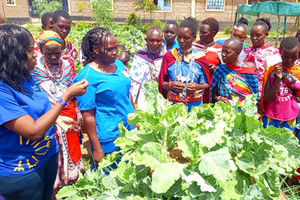Kenya struggling to feed infants and young children

A child is screened for malnutrition at Kanamkuny village,Turkana County on October 11, 2022.
What you need to know:
- The Health ministry collaborated with Global Alliance for Improved Nutrition (Gain) and the United Nations International Children’s Emergency Fund (Unicef) to conduct the research.
- According to the researchers, proper feeding is essential for children’s health and development although Kenya, despite being a fast-growing economy with a constitutional right to nutrition and health for every child, has made little progress on this front.
Kenya is struggling to provide infants and young children with a variety of nutritious and safe foods as they continue to breastfeed, a new report by the Health ministry has revealed.
The ministry collaborated with Global Alliance for Improved Nutrition (Gain) and the United Nations International Children’s Emergency Fund (Unicef) to conduct the research.
According to the researchers, proper feeding is essential for children’s health and development although Kenya, despite being a fast-growing economy with a constitutional right to nutrition and health for every child, has made little progress on this front.
They add that the quality of children’s diets during the complementary feeding period (the period of transition from exclusive breastfeeding to consuming a wide range of foods in addition to breast milk) is determined by the adequacy of complementary foods (quantity and diversity), which is further determined by availability, accessibility and affordability.
“Optimal complementary feeding between the ages of six and 23 months provides children with the required range of nutritious and safe foods while continuing to be breastfed to meet their needs for essential nutrients and develop their full physical and cognitive potential,” notes the researchers in a special issue published in the scientific journal Maternal & Child Nutrition. The special issue highlights findings from collaborative research to understand barriers to optimal complementary feeding and how to improve nutrition for young children in Kenya.
“The rates of exclusive breastfeeding in the first six months of life have increased from 32 per cent in 2008 to 60 per cent in 2022 in Kenya,” the study highlights while noting that, “however, the proportion of children between six and 23 months receiving a minimum acceptable diet remains low and has declined from 39 per cent in 2008 to 31 per cent in 2023.”
The researchers also disclose that a secondary analysis of household surveys and food composition data was conducted to outline children’s dietary patterns within the different regions of Kenya and the extent to which the affordability of animal-source foods could be improved. Most children do not receive a diverse and adequate diet and they suffer from high burdens of micronutrient deficiencies and anaemia.
Veronica Kirogo, Kenya’s acting Head Division of Family Wellness, Nutrition and Dietetics at the Health ministry, said their research collaboration with Unicef and GAIN provides an evidence base to guide policies and programmes to improve young children’s nutrition nationally and regionally. “The special issue also proposes a roadmap for operationalising a national complementary feeding strategy that is multisectoral, well-coordinated and tailored to the regional needs and priorities in Kenya. “
“It is available online and can be accessed for free as it is an essential resource to inform and inspire policymakers, programme managers, health workers, researchers, and donors to take action to improve early childhood nutrition in the country.”
Dr Ismael Teta, chief nutrition, Unicef Kenya Country Office, reminded that good nutrition in early childhood provides a strong foundation for growth, health and development.
“This special issue outlines practical actions Kenya can take to promote adequate, safe, and nutritious complementary foods for infants and young children. We look forward to supporting the government in translating these findings into impactful policy and programs that give every child the best start in life.”
Dr Ty Beal, research advisor at Gain, said: “Across all studies a common theme emerged: location, location, location. The barriers to optimal complementary feeding vary by location and require tailored approaches, which should be feasible given the decentralised government in Kenya.”
The partners highlighted four key issues that stand out in their findings.
“Complementary feeding diets in Kenya are often inadequate in iron, zinc, calcium and animal-source protein, which can lead to poor growth and development,” they observed while also noting a second major issue.
“There exist local, nutritious foods that are relatively affordable and can help fill the nutrient gaps, such as small dried fish, dark green leafy vegetables, liver, milk and eggs.”
Thirdly, certain strategies according to the experts may help improve the affordability of highly nutrient-dense animal-source foods, such as increasing livestock production efficiency, and improving trade and transportation infrastructure.
“Caregivers’ barriers to optimal complementary feeding include food affordability, perceived food safety and health benefits, child acceptability, ease of acquisition, convenience to prepare, child illnesses, and seasonal variations in food availability, “they added.





